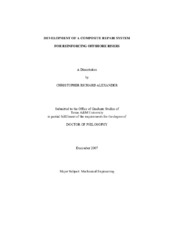| dc.description.abstract | A research program was conducted to investigate the application of composite materials
in repairing corroded offshore risers, leading to the development of an optimized repair
using a hybrid carbon/E-glass system. The objective of this research program was to
investigate the feasibility of extending onshore composite repair techniques to offshore
risers by developing integrated analytical and experimental methods. The study
considered loads typical for offshore risers including internal pressure, tension, and
bending. To fulfill this objective efforts included a state of the art assessment of current
composite repair technology, designing a carbon-based composite repair system
optimized by numerical simulation with prototype testing, and providing guidelines for
industry in repairing and reinforcing offshore risers using composite materials.
Research efforts integrated numerical modeling, as well as full-scale testing that included
four composite repair manufacturers to assess the current state of the art on pipe samples
with simulated corrosion reinforced with composite materials. Analysis and testing were
also performed on the optimized carbon/E-glass system. The results of this program
demonstrated that composite materials are a viable means for repairing corroded offshore
steel risers as adequate reinforcement ensures that the steel risers are not loaded beyond
acceptable design limits. For corroded risers, the results demonstrated through analysis
and full-scale testing efforts that properly designed composite repair systems can provide
adequate structural reinforcement to ensure that excessive strains are not induced in the
steel when subjected to internal pressure, axial tension, and bending design loads. This
was verified experimentally using strain gages placed beneath the composite repair. This program is the first of its kind and is thought to contribute significantly to the future
of offshore riser repairs. It is likely that the findings of this program will foster future
investigations involving operators by integrating their insights regarding the need for
composite repair based on emerging technology. One of the most significant
contributions to the existing body of work is the use of limit analysis in developing
design limits for the repair of steel pipes using composite materials. | en |


